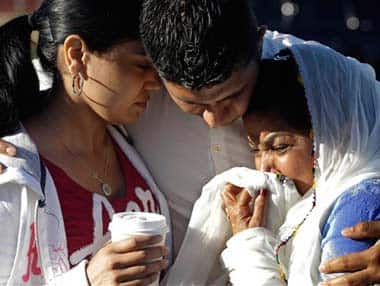There is much soul-searching these days about whether the gurdwara tragedy in Wisconsin is an American tragedy or just a tragedy in America. Coming as it did on the heels of the Aurora Batman massacre, the contrast is quite clear. You can measure it in the political reactions. You can count the number of politician statements issued. President Obama went to Aurora but just made a carefully-worded statement this time about Sikhs as members of the “broader American family” as if they were “some distant relatives” notes Naunihal Singh in the New Yorker. Romney goofed by confusing Sikhs and sheikhs. Neither presidential candidate visited Wisconsin and no one suspended campaigning even for a day. Two days after the rampage, only CNN had sent its anchors to report live from Wisconsin
reports
Politico. The others pleaded Olympics, if they pleaded anything at all. [caption id=“attachment_418256” align=“alignleft” width=“380”]
 Has the American media failed to cover the incident with the same depth as the Aurora theatre shooting? AP[/caption] So what’s the difference? It’s not that Wisconsin lacked in heroism or poignancy. The gunman in Wisconsin hated the other with a deep-rooted scary malevolence – and that other was not just Sikh or Muslim but also blacks, Jews, Latinos, basically anyone who did not look like him. Wade should terrify all Americans,
writes
Naunihal Singh, just as Aurora shooter James Holmes scared everyone, not just those who like to watch midnight movie premieres.
Has the American media failed to cover the incident with the same depth as the Aurora theatre shooting? AP[/caption] So what’s the difference? It’s not that Wisconsin lacked in heroism or poignancy. The gunman in Wisconsin hated the other with a deep-rooted scary malevolence – and that other was not just Sikh or Muslim but also blacks, Jews, Latinos, basically anyone who did not look like him. Wade should terrify all Americans,
writes
Naunihal Singh, just as Aurora shooter James Holmes scared everyone, not just those who like to watch midnight movie premieres.
Sadly, the media has ignored the universal elements of this story, distracted perhaps by the unfamiliar names and thick accents of the victims’ families. They present a narrative more reassuring to their viewers, one which rarely uses the word terrorism and which makes it clear that you have little to worry about if you’re not Sikh or Muslim.
The problem for America’s media lies on both ends of the gun. The victims are immigrants with thick accents and multi-syllabic names. It’s not that the American media is unsympathetic to their plight but a gurdwara is just not “mainstream” in the way a movie theatre is. The viewing public can imagine themselves in the darkness of the theatre. But they don’t see themselves in a gurdwara though they might leave flowers outside it as a mark of respect. On the other end of the gun, the assailant is a white supremacist. As Juan Cole points out succinctly in his handy list to spot the top ten differences between White Terrorists and Others (read the full list here )
White terrorists are called “gunmen." What does that even mean? A person with a gun? Wouldn’t that be, like, everyone in the US? Other terrorists are called, like, terrorists. White terrorists are called “troubled loners.” Other terrorists are always suspected of being part of a global plot, even when they are obviously troubled loners.
Of course, white terrorists are never called white terrorists. They have names like Wade Michael Page or Anders Breivik. They are individuals. How many of us remember the name Shahzad Tanweer? He was one of the men behind the 7/7 London subway bombings. Those men were just lumped together as jihadists. Their identity is always defined by their community: Muslim, immigrant, or son of immigrants. But here’s the dirty secret that American media does not want to acknowledge. America’s real terrorist threat does not come from Osama clones these days. As Steve Coll points out, also in the New Yorker based on a study from Syracuse University and the New America Foundation:
The entire decade-long domestic death toll from terrorism (that is, where a political or ideological motive was apparent) was thirty. By comparison, the rate of annual deaths from mass shootings by non-ideological deranged killers—such as the gunman who attacked moviegoers in Aurora, Colorado, last month—runs more than thirty times higher (on average, about a hundred deaths each year). In all, there are about fifteen thousand murders in America each year. Of the three hundred domestic-terrorism cases studied, about a quarter arose from anti-government extremists, white supremacists, or terrorists animated by bias against another religion. And all of the most frightening cases—involving chemical, biological, and radiological materials—arose from right-wing extremists or anarchists. None arose from Islamist militancy.
Does that mean Islamic militancy is defanged? Of course not. Does it mean American homeland security measures have been successful? Perhaps. But the imbalance in the discourse, the blindness to one narrative while going full bore on the other, is something much more dangerous than the often lobbed charge of racism. It allows American media to pretend that Timothy McVeigh or Wade Michael Page are all individual shooting stars whose stories end with their deaths. That, in effect, allows the American public to close its eyes to the terrorist threat in its own backyard. And how do you take safety measures against that?
)